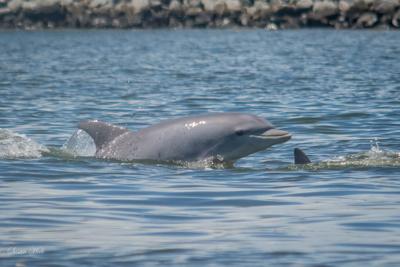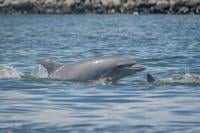CHESAPEAKE BAY - The Chesapeake Bay is world-renowned for its blue crabs, rockfish, osprey, and menhaden. But a certain marine mammal, less associated with the Bay but a frequent visitor, has captured the curiosity of scientists. Researchers with the University of Maryland Center for Environmental Science (UMCES) are asking for your help in tracking dolphins in Chesapeake Bay waters as they look into what brings the iconic animal to our aquatic backyard - and there’s an app for that.
“Dolphins are beautiful, charismatic animals and one of the largest inhabitants of the Chesapeake Bay,” UMCES’ Chesapeake Dolphin Watch website reads. “But we know very little about them. When, where and why do they visit the Bay? We need your help to find out!”
In 2017, researchers with Chesapeake Dolphin Watch launched their own app to let anyone assist in answering questions such as how often dolphins come into the Bay, how long they spend here, and what areas they use and why. The app allows you to tag where you’ve spotted a dolphin, and each entry helps UMCES scientists learn more about the marine mammals and their behavior.
According to user-submitted reports on the app, dolphins have recently been spotted in the Honga River near Hoopers Island, off of Taylors Island, the mouth of the Choptank River, and well into the Wye River.
WBOC spoke with Jamie Testa, project coordinator for Chesapeake Dolphin Watch, on what they’ve learned so far from “citizen scientists” using the app.
“We have observed a seasonal pattern of dolphins that visit the Chesapeake Bay,” Testa said. “So we see that they come in when the waters are warm. They hang around for the summer and seem to head back out right around the fall. In terms of where they go each year and how many, that's a different question.”
Chesapeake Dolphin Watch says nearly 18,000 people have downloaded their app since launching, and Testa says they get about 1,000 dolphin sightings reported every year. That coverage, according to Testa, is invaluable for scientists who can’t be everywhere at once.
“The coverage that we can get from our citizen scientists, who we just call dolphin watchers, is incredible. We can cover the entire Chesapeake Bay, the rivers, the creeks, pretty much all of the tributaries with the power of our volunteers out there.”
Testa encourages anyone who finds the perfect time to enjoy the waters of the Chesapeake Bay, such as on a picturesque holiday weekend, to download the app and get the chance to participate in scientific research.
As to why dolphins come to the Chesapeake, Testa says the evidence points to food supplies and maternal instincts. The Bay’s numerous fish species provide plenty of feeding options for bottlenose dolphins, while the lack of large predators makes the local waters ideal for raising young.
While scanning for dolphins on the Chesapeake, Testa urges watchers to keep safety in mind. Keeping our distance from the cetaceans is critical.
“We want to encourage safe boating practices, obviously, first and foremost, especially this weekend when folks are out for the holiday,” Testa said on July 3. “But in addition to that, keeping the dolphins and the humans safe is so important. So we want to make sure that we stay at least 50 yards away from the dolphins.”
Those fishing can also help prevent entanglements by pulling in fishing lines when dolphins are present. Lastly, making sure we clean up our trash to prevent it becoming a risk to marine life is extremely important, Testa tells WBOC.
For more information on Chesapeake Dolphin Watch, you can visit UMCES’ site here.


